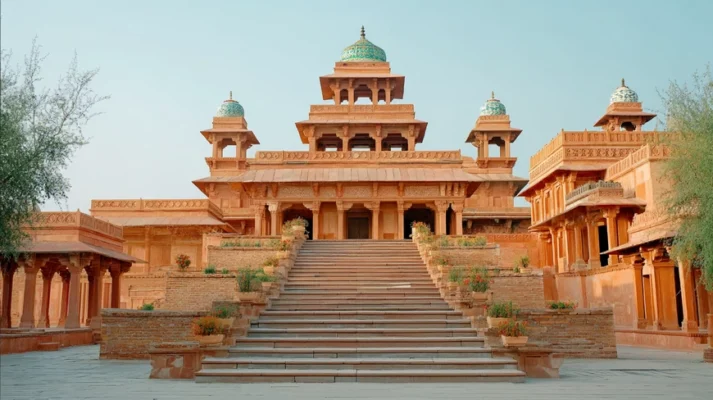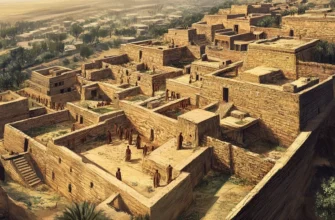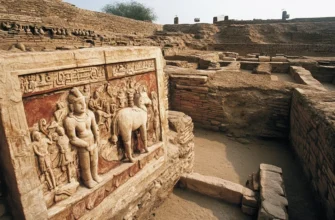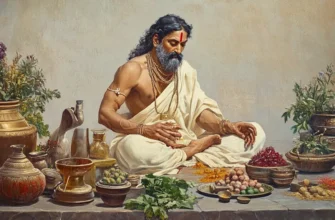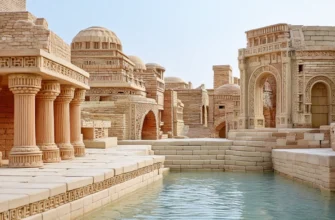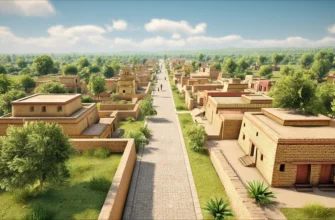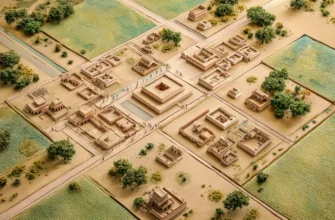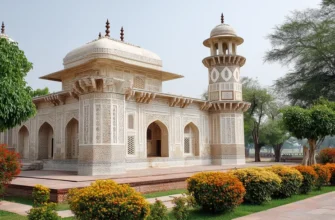Fatehpur Sikri is a unique ghost town that was the capital of the Mughal Empire during the reign of Akbar in the 16th century. Founded in 1571, it became a symbol of power and prosperity, but due to a lack of water, it was abandoned after only 14 years.
The architecture of Fatehpur Sikri combines Muslim and Hindu styles. Among the most notable sights are the magnificent Jama Masjid mosque, the monumental Buland Darwaza gate, the Jodha Bai Palace, and the five-story Panch Mahal.
Today, the city is a UNESCO World Heritage Site and attracts tourists with its historical atmosphere. When visiting Fatehpur Sikri, you can feel the spirit of an empire that changed the course of Indian history.
History
Fatehpur Sikri was founded by Emperor Akbar in 1571 as the new capital of the Mughal Empire.
Legend has it that Akbar, having no heir, sought the blessing of the Sufi saint Salim Chishti, who lived in the small village of Sikri. Soon, the ruler had a son, and as a sign of gratitude, he ordered a grand city to be built here.
Fatehpur Sikri quickly became the political, administrative, and cultural center of the empire. Its name means “City of Victory” (from the Persian Fatehpur, meaning “city of victory”), symbolizing Akbar’s triumph after the successful conquest of Gujarat.
However, due to a lack of water, the city was unable to function as the capital for long. As early as 1585, the court moved to Lahore, and Fatehpur Sikri gradually emptied, becoming a ghost town that preserved the magnificent architecture and spirit of the Mughal era.
Fatehpur Sikri reached its peak in 1571–1585, when Emperor Akbar made it the capital of the Mughal Empire. The city became an important political, administrative, and cultural center. Grand palaces, mosques, caravanserais, and residential quarters were built here.
The architecture of Fatehpur Sikri combined Hindu, Persian, and Islamic styles, creating a unique ensemble. The city had schools, workshops, and markets, and Akbar’s court attracted scholars, artists, and poets.
Despite its prosperity, Fatehpur Sikri had one critical flaw: a lack of water. Due to its geographical location, the city could not provide sufficient water resources for the population and the army.
In 1585, Akbar decided to move the capital to Lahore, closer to the northwestern borders of the empire, in order to more effectively manage military campaigns. Fatehpur Sikri was deserted, and although it remained an important religious center, most of the buildings were abandoned.
Today, the city is a UNESCO World Heritage Site and attracts tourists as one of the best-preserved examples of Mughal architecture.
Architectural heritage
Fatehpur Sikri is an architectural masterpiece that combines Hindu, Persian, and Islamic traditions. The city’s buildings are constructed of red sandstone, giving it a unique appearance.
Main attractions of Fatehpur Sikri
Jama Masjid (Great Mosque)
One of the largest mosques in India, built in the style of Persian mosques. In its courtyard is the mausoleum of the Sufi saint Salim Chishti, whose tomb is made of white marble.
Jama Masjid is one of the largest mosques in India, located in Fatehpur Sikri.
It was built in 1571 by Emperor Akbar and became the main religious center of the city.
The mosque is built in the traditional Mughal style using red sandstone and white marble.
It has a spacious courtyard surrounded by arched galleries and a main prayer hall with high domes.
The most impressive element of the mosque is the Buland Darwaza, a monumental gate 54 meters high, symbolizing the grandeur and power of the Mughal Empire.
In the courtyard of the mosque is the tomb of the Sufi saint Salim Chishti, a white marble mausoleum with intricate carved grilles (jali). It is considered a sacred place where pilgrims come with their prayers and wishes.
Jama Masjid remains one of the most important Muslim shrines in India and an important historical monument reflecting the religious and cultural heritage of Fatehpur Sikri.
Buldak Darwaza (Gate of Victory)
Buldak Darwaza is a monumental gate that is one of the most famous architectural monuments of Fatehpur Sikri. It was built by Emperor Akbar in 1601 to commemorate his victory over Gujarat.
The name “Buland Darwaza” translates as “High Gate,” which perfectly matches its grandiose appearance.
The gate is 54 meters high, making it the tallest gate in the world from the Mughal era.
They are made of red sandstone with inlays of white and black marble.
The architecture combines Persian, Hindu, and Islamic styles, emphasizing the syncretism of the Great Mughal Empire’s culture.
An inscription from the Quran is carved on the gate, reminding us of the modesty and transience of earthly power.
The Buland Darwaza leads to the Jama Masjid, emphasizing its religious and historical significance. Today, these magnificent gates are a symbol of Akbar’s power and attract thousands of tourists from all over the world.
Jodha Bai Palace
Jodha Bai Palace is the largest and most luxurious residence in Fatehpur Sikri, built for one of Emperor Akbar’s main wives, the Hindu princess Jodha Bai. It is a striking example of the fusion of Hindu and Islamic architecture.
Materials: the palace is built of red sandstone and decorated with intricate carved ornaments.
Hindu elements: numerous balconies, lattice windows (jali), temples, and carved columns with lotus motifs.
Islamic influence: arches, domed pavilions, and geometric patterns.
Spacious grounds: the palace has a large inner courtyard connected to other buildings in the city by corridors and gardens.
This residence symbolizes the religious tolerance of Akbar, who sought to unite Muslim and Hindu cultures. Today, the Jodha Bai Palace is one of the most important historical monuments in Fatehpur Sikri.
Panch Mahal (Five-Tiered Palace)
Panch Mahal is a unique five-story building in Fatehpur Sikri that served as a place of rest for the imperial court. The name translates as “Five-Tiered Palace,” reflecting its structure.
Cascading structure: the building consists of five levels, each of which decreases in size as it rises.
68 columns: the entire palace is supported by carved columns, which create an open, airy layout.
Absence of walls: instead, openwork lattice partitions (jali) were used, allowing for natural ventilation.
Panoramic view: the upper tier offers a view of the entire city of Fatehpur Sikri.
Panch Mahal was used as a place of rest for the women of the imperial harem, where they could enjoy the fresh air and coolness. Cultural events and musical performances were also held here.
Thanks to its unique architecture and sophistication, Pancha Mahal is one of the most interesting sights of Fatehpur Sikri, reflecting the grandeur and luxury of the Akbar era.
Diwan-i-Khas (Hall of Private Audiences)
Pancha Mahal (Five-Tiered Palace) is one of the most remarkable architectural monuments of Fatehpur Sikri, located in India. This palace was built during the reign of Emperor Akbar in the late 16th century.
Panch Mahal consists of five tiers, each of which served a different purpose. It is noted that each floor was built using different architectural styles, combining Hindu, Muslim, and Persian motifs. This palace was usually a place of rest and entertainment for the emperor and his court, with a magnificent view of the surrounding lands.
Architecturally, Panch Mahal is very impressive with its scale and lightness of construction — the palace has open galleries, columns, and arches that give it elegance. The palace has no roof, which allows the air to cool during the hot season and also allows you to enjoy panoramic views of the city.
This palace is part of the Fatehpur Sikri complex, which was the former capital of the Mughal Empire. Today, Panch Mahal is a popular tourist attraction where you can see elements of traditional Indian architecture that served as a model for many palaces of that time.
Fatehpur Sikri is one of the best-preserved historical cities in India. Its architectural heritage is impressive for its elegance and richness of detail, reflecting the grandeur of the Mughal Empire.
Significance of the city in Indian history
Fatehpur Sikri plays an important role in Indian history, particularly in the history of the Mughal Empire. The city was founded by Emperor Akbar in 1569 as the new capital of the empire and remained so for several years. Here are some key aspects of its historical significance: Political center of the Mughal Empire: Fatehpur Sikri became the new capital after Emperor Akbar decided to move the administrative and political center of the empire from Agra. The city became an important political, cultural, and religious center for the Mughals. Huge architectural complexes, including palaces, mosques, and administrative buildings, served as symbols of Mughal grandeur. Religious center: Akbar is known to have actively promoted religious tolerance.
In Fatehpur Sikri, he founded a new religious movement called Din-i-Ilahi, which combined elements of Islam, Hinduism, Jainism, and Christianity. At the same time, the city became an important center for Hindu, Muslim, and other religious communities.
Cultural center: Fatehpur Sikri was a center of culture and science during the reign of Akbar. The city attracted scholars, artists, and poets from across the empire and abroad. The city’s architecture was a magnificent example of cultural synthesis, combining different traditions and styles to create a unique image of the Mughal era.
Economic center: As the capital, Fatehpur Sikri became an important economic and commercial hub. The city served as a place for the development of crafts, trade, and agriculture.
Symbol of victory: The name Fatehpur Sikri translates as “City of Victory,” and the city was founded after Akbar’s great victory over Raja Hem Chandra, the ruler of the Rajputs, which became a symbol of Mughal victory and political dominance in the region.
Although the city became uninhabited and abandoned in the late 16th century due to changes in the political situation and water supply problems, its architectural and cultural significance continues to impress today. Fatehpur Sikri remains an important UNESCO World Heritage Site and a popular tourist destination.
Cultural and religious center
Fatehpur Sikri was not only a political but also a cultural and religious center during the reign of Emperor Akbar. Its role in these areas can be seen in several aspects:
Cultural center:
Synthesis of cultures: Fatehpur Sikri became a meeting place for different cultural and religious traditions. Akbar, who actively supported cultural integration, encouraged interaction between Hindus, Muslims, Jains, and Christians. This contributed to the development of a unique cultural environment, which was reflected in architecture, science, art, and literature.
Development of art and science: The city became a center for scholars, poets, architects, artists, and musicians. Among those who worked in Fatehpur Sikri were important cultural figures such as artists who created unique miniatures and poets who wrote in a multicultural environment. Persian poetry flourished at the court of Akbar.
Architectural style: The architecture of Fatehpur Sikri was a striking example of cultural synthesis. The combination of Hindu, Muslim, and Persian elements in the design of palaces, mosques, and other buildings reflected Akbar’s cultural policy. For example, the Jami Masjid (mosque), with its majestic arches and courtyards, reflects classical Muslim traditions, while the Panch Mahal palace has elements of Hindu architecture.
Intellectual center: The city became an important place for the development of science and education. Numerous scholars, philosophers, doctors, astronomers, and mathematicians worked at Akbar’s court in Fatehpur Sikri, contributing to the advancement of knowledge. Akbar, known for his love of science, even established the “List of Nine Crystals” (Navratni), a group of prominent intellectuals who advised the emperor on various issues.
Religious center:
Akbar’s religious tolerance: One of the main features of Akbar’s reign was his policy of religious tolerance. He sought to unite the various religious communities of the empire and create a common environment for peaceful coexistence.
In Fatehpur Sikri, Akbar held important religious meetings where issues of interfaith relations were discussed. Din-i-Illahi: In Fatehpur Sikri, Akbar founded a new religious movement called Din-i-Illahi, meaning “Religion of God.”
This movement combined elements of Islam, Hinduism, Jainism, and other religions and sought to achieve spiritual unity. Although this religion did not gain widespread popularity, it is an important part of the history of religious thought at that time.
Mosque and spiritual center: An important religious site in the city was the Jami Masjid, one of the largest and most important mosques in India at the time. It became not only a place of worship but also a symbol of religious practice at the emperor’s court.
The mosque served as a center for spiritual leaders and believers of different religions, which also demonstrates a policy of religious tolerance. Sufism and spirituality: Sufis, who had a great influence on Akbar, played an important role in the religious atmosphere of Fatehpur Sikri.
In particular, Sheikh Salim Chisti, a Sufi saint who lived in Fatehpur Sikri, held a special place at the emperor’s court. On his advice, Akbar built one of the largest mosques and a special tomb for Sheikh Salim Chisti, which became an important religious and cultural site for pilgrims.
Fatehpur Sikri became an important cultural and religious center not only because of its architectural beauty, but also because of its policy of religious tolerance, which allowed different communities to coexist and contributed to the development of a rich cultural and religious heritage. The city reflected Akbar’s desire to create a unified, diverse but cohesive empire where culture and religion interacted, promoting peaceful coexistence and development.
Fatehpur Sikri today: a tourist attraction
Today, Fatehpur Sikri is one of India’s main tourist attractions and a UNESCO World Heritage Site. Once a huge political and cultural center of the Mughal Empire, the city attracts thousands of tourists from all over the world with its architectural beauty, historical significance, and ancient city atmosphere.
Fatehpur Sikri impresses with its architectural grandeur, combining Muslim, Hindu, and Persian styles. The main architectural attractions are the Panch Mahal Palace, a five-story building with open galleries, which is a wonderful example of Mughal architecture, the Jama Masjid, one of the largest mosques of its time, with spacious courtyards and high arches, and the tomb of Sheikh Salim Chisti, a holy place for pilgrims, where the tomb of a Sufi saint who played an important role in the life of Akbar is located. One of the largest architectural structures is the Ballistic Gate, a huge arch that served as the main entrance to the palace complex.
The city is an important part of the history of the Mughal Empire, and here you can not only see architectural monuments, but also learn about important events that took place during the reign of Emperor Akbar.
Fatehpur Sikri became the place where Akbar built his capital and pursued a policy of religious tolerance and cultural synthesis. This city became a symbol of the empire’s power and cultural wealth. Today, Fatehpur Sikri attracts tourists who want to experience the atmosphere of a huge Mughal city.
Visitors can stroll among ancient buildings, visit religious sites such as the tomb of Sheikh Salim Chisti, and learn about his influence on the emperor while enjoying the architectural forms and details that have been preserved to this day. In addition to tourists, the city also attracts pilgrims, especially to the tomb of Sheikh Salim Chisti. According to legend, Emperor Akbar turned to this saint for blessings for the birth of his son, and many people, especially Muslims, visit this place hoping for blessings and the fulfillment of their wishes.
Fatehpur Sikri is well developed for tourists: there are museums, excursions, and guides who help you learn more about the history of the city, its architecture, and culture. The city is located about 40 km from Agra, making it easily accessible for tourists staying in Agra. Various cultural events and festivals are also held here, allowing visitors to immerse themselves in Indian traditions.
In addition to its historical and architectural attractions, Fatehpur Sikri attracts visitors with its natural beauty. The city is located on a high hill, offering magnificent views of the surrounding landscapes and countryside. Fatehpur Sikri is not only a monument of the past, but also a living center of culture and history that attracts tourists and pilgrims from all over the world.
Conclusion
Fatehpur Sikri is now an important tourist attraction that combines a wealth of history, culture, and architecture. This city, once the political and religious center of the Mughal Empire, continues to captivate visitors with its grandeur, unique architectural monuments, and spiritual atmosphere. Its significance in the history of India, especially during the reign of Emperor Akbar, remains unforgettable.
Today, Fatehpur Sikri is not only a place to learn about the past, but also a vibrant cultural center that attracts tourists and pilgrims from all over the world. Fatehpur Sikri is worth visiting for its unique blend of history, culture, and architecture.
This city, once the capital of the Mughal Empire, is now a living testimony to the grandeur of that era. Impressive architectural landmarks such as the Panch Mahal Palace, Jami Masjid, and the tomb of Sheikh Salim Chisti allow visitors to experience the atmosphere of the Mughal era. In addition, Fatehpur Sikri is an important religious center where different cultures and religions coexist, making it not only a historical but also a spiritual place. It is the perfect destination for those who want to immerse themselves in India’s rich heritage and enjoy the stunning landscapes and architectural beauty.
